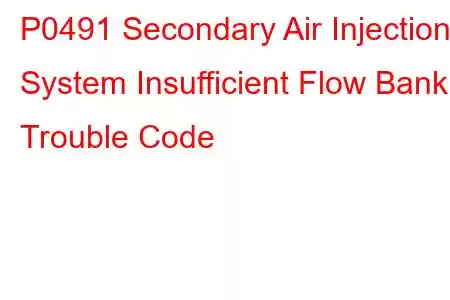P0491 Secondary Air Injection System Insufficient Flow Bank 1
OBD-II Trouble Code Technical Description
Secondary Air Injection System Insufficient Flow (Bank 1)
What does that mean?
This is a generic powertrain code, which means it covers all makes/models, 1996-newer.
However, specific troubleshooting steps will vary depending on the vehicle.
The secondary air injection system, commonly found on Audi, BMW, Porsche and VW vehicles – and may be found on other vehicles – features an air pump, an exhaust manifold, an input check valve, vacuum control switch, an electrical input circuit for the vacuum control switch and tons of vacuum hoses.
This system pumps fresh air into exhaust system during cold starts to feed oxygen and exhaust gases. This ensures a more complete burn of harmful emissions – hydrocarbons. After about minute, the system turns itself off.
If the air pump and check valve are faulty, they are normally easier to replace; however, many of the vacuum lines are under or behind the intake manifold. This makes them difficult to reach in most cases. The P0491 code tell there is a fault with the system – usually that the secondary air flow is too low on bank 1. Bank #1 is the side of the engine with cylinder #1. For bank #2, see code P0492.
Other secondary air injection system trouble codes include P0410, P0411, P0412, P0413, P0414, P0415, P0416, P0417, P0418, P0419, P041F, P044F, and P0492.
Symptoms
Symptoms of a P0491 engine code may include.
Malfunction Indicator Lamp (MIL) illuminationPotential Causes
Potential causes for a P0491 may include:
Faulty exhaust manifold check valve A fuse or relay for the secondary air injection pump may be faulty A faulty air pump Leaking vacuum hose A bad vacuum control switch A dislodged a vacuum line A leak in the hoses/piping between the secondary air injection pump and the Combi or secondary air injection A sensor for the secondary air pressure may be faulty The combi valve itself is faulty The secondary air injection port in the cylinder head may be plugged with carbon The secondary air injection ports in the cylinder head may by cloggedDiagnostic and Repair Procedures
Most of the diagnostic tests must be done when the engine is completely cold. Some of the follow-up tests may have to wait until the engine completely cools down again – usually a few hours. Some of the tests may also generate additional fault codes. Just remember to clear all of the fault codes when you have found and repaired the problem.
1. Check the pump. Be sure the engine is completely cold. Remove the pressure hose from the pump or from the manifold check valve – whichever is easier to reach. Have someone start the engine while you check to see that the pump is running and pumping air out of the end of the hose or outlet nipple (depending on where you disconnected it). If air is pumping, then go to step 4; if not, go to step 2.
2. Unplug the electrical harness connector from the pump. Apply 12 volts to the pump with jumper wires. The terminal with the brown wire is ground and the other terminal is positive. If the pump runs go to step 3; if not, the pump must be replaced.
3. Make sure the engine is cold, connect the multimeter, then have someone start the engine to do this step. Test the pump harness connector to ensure that it has 12 volts by checking power between the two terminals in the pump harness plug. If you have 12 volts, repeat the first three steps to ensure you did not make a mistake. If you don't have 12 volts, check the fuses and the relay. If you do find a bad fuse or rely, replace it, then repeat this step to ensure you have power at the harness.
4. Make sure the engine is completely cold. Remove the pressure hose from the check valve. Check to see if air is coming out of the hose when you start the engine. Do
Read: 43


